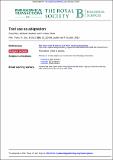Files in this item
Tool use as adaptation
Item metadata
| dc.contributor.author | Biro, Dora | |
| dc.contributor.author | Haslam, Michael | |
| dc.contributor.author | Rutz, Christian | |
| dc.date.accessioned | 2014-01-27T17:01:01Z | |
| dc.date.available | 2014-01-27T17:01:01Z | |
| dc.date.issued | 2013-11-19 | |
| dc.identifier | 71706378 | |
| dc.identifier | cbeffc3d-4796-4647-8ca5-107248b1e2a9 | |
| dc.identifier | 84885199355 | |
| dc.identifier.citation | Biro , D , Haslam , M & Rutz , C 2013 , ' Tool use as adaptation ' , Philosophical Transactions of the Royal Society. B, Biological Sciences , vol. 368 , no. 1630 , 20120408 . https://doi.org/10.1098/rstb.2012.0408 | en |
| dc.identifier.issn | 0962-8436 | |
| dc.identifier.other | ORCID: /0000-0001-5187-7417/work/60427590 | |
| dc.identifier.uri | https://hdl.handle.net/10023/4421 | |
| dc.description.abstract | Tool use is a vital component of the human behavioural repertoire. The benefits of tool use have often been assumed to be self-evident: by extending control over our environment, we have increased energetic returns and buffered ourselves from potentially harmful influences. In recent decades, however, the study of tool use in both humans and non-human animals has expanded the way we think about the role of tools in the natural world. This Theme Issue is aimed at bringing together this developing body of knowledge, gathered across multiple species and from multiple research perspectives, to chart the wider evolutionary context of this phylogenetically rare behaviour. | |
| dc.format.extent | 404139 | |
| dc.language.iso | eng | |
| dc.relation.ispartof | Philosophical Transactions of the Royal Society. B, Biological Sciences | en |
| dc.subject | Technological evolution | en |
| dc.subject | Ontogeny | en |
| dc.subject | Culture | en |
| dc.subject | Cognition | en |
| dc.subject | Anatomy | en |
| dc.subject | Social learning | en |
| dc.subject | QL Zoology | en |
| dc.subject.lcc | QL | en |
| dc.title | Tool use as adaptation | en |
| dc.type | Journal article | en |
| dc.contributor.sponsor | BBSRC | en |
| dc.contributor.institution | University of St Andrews. School of Biology | en |
| dc.contributor.institution | University of St Andrews. Centre for Social Learning & Cognitive Evolution | en |
| dc.contributor.institution | University of St Andrews. Centre for Biological Diversity | en |
| dc.identifier.doi | https://doi.org/10.1098/rstb.2012.0408 | |
| dc.description.status | Peer reviewed | en |
| dc.identifier.grantnumber | BB/G023913/2 | en |
This item appears in the following Collection(s)
Items in the St Andrews Research Repository are protected by copyright, with all rights reserved, unless otherwise indicated.

